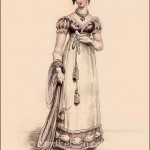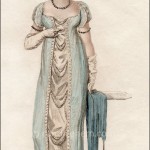La Belle Assemblée, February 1809.
“Evening Dresses in January 1809.”
 This print shows two views of the same dress, which is very unusual for this magazine. The quality of the print is also not as well-drawn or as detailed as those of the previous year and the rest of this year. (In fact, by the end of 1809, the prints were of an extremely high quality, both in the engraved design and the hand-coloring.) It looks as though a different, and somewhat less talented, artist was used for this print only, as even the second print for this month is much more well executed.
This print shows two views of the same dress, which is very unusual for this magazine. The quality of the print is also not as well-drawn or as detailed as those of the previous year and the rest of this year. (In fact, by the end of 1809, the prints were of an extremely high quality, both in the engraved design and the hand-coloring.) It looks as though a different, and somewhat less talented, artist was used for this print only, as even the second print for this month is much more well executed.
The overdress is called a Fontarabian robe, named after the Spanish town of Fuenterrabia. Fashion elements and accessories were often named for victorious battles in the Peninsular Wars, but I can find no mention of a battle in or near Fuenterrabia in 1809.
The print is described in the magazine as follows:
“Fontarabian robes of Saragossa brown net, worn over white satin or sarsnet; the front breadth ornamented with borders of vandyke lace, terminated at the extreme edge with gold cord, or narrow binding. Stomacher of white satin, laced with gold. Short sleeve of correspondent materials. A drapery flowing from the right shoulder (where it is confined with a brooch) is trimmed semblable to the front of the robe ( as seen in Fig. 1 of the Plate), and falling in graceful negligence round the back of the figure, is trimmed on the left side with a gold tassel. A pelerine, or Pilgrim’s tippet, of lace, brough to point in front of the figure, and confined with gold brooches on the shoulders, forms a graceful finish for the bust. A Patriotic hat of white satin, frosted velvet, or silver tissue, with Gallician plume. Hair worn in irregular ringlets. Diamond earrings, necklace, and bracelets. Shoes of white satin, with silver rosettes and fringe. Gloves of French kid.
“The different terms applied to the various articles which compose the elegant habiliment will, of course, bespeak it entirely Spanish; and we here take occasion to remark, that it is equally consistent and attractive if formed of any fashionable coloured crape, or fancy leno.”







